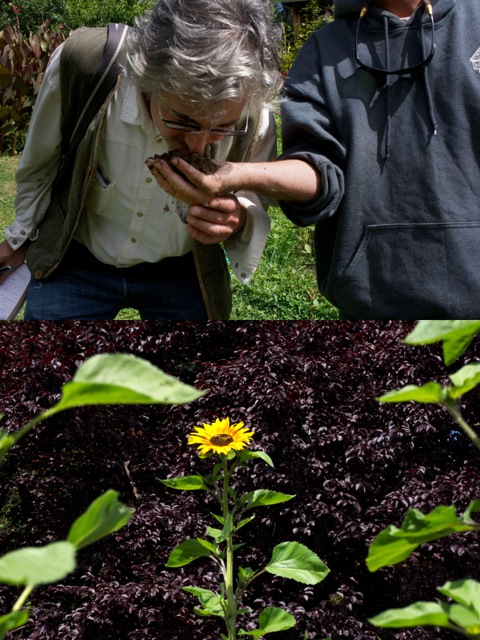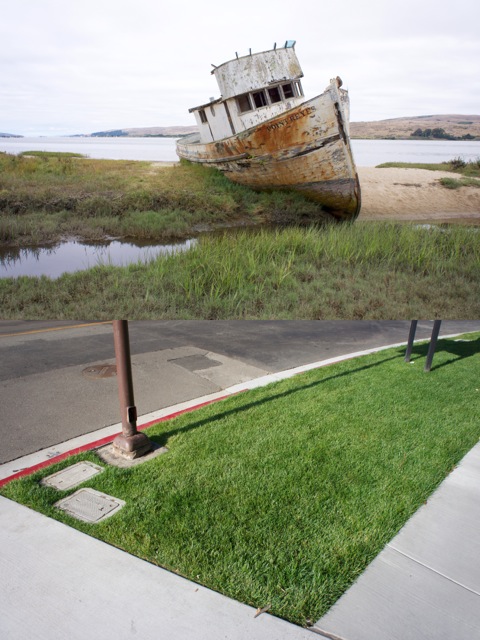Posted - 09/18/2012 The Latest Dirt on the California Ag Road Trip by Mark Schapiro
 Being a journalist accustomed to stories in far-off foreign places, I
did not expect to have the same sensation in traveling to the
food-growing regions of California. But taking a journey into the
state's agricultural centers with photographer Peter Cunningham, my ITP collaborator, was indeed like a journey into a foreign land.
Being a journalist accustomed to stories in far-off foreign places, I
did not expect to have the same sensation in traveling to the
food-growing regions of California. But taking a journey into the
state's agricultural centers with photographer Peter Cunningham, my ITP collaborator, was indeed like a journey into a foreign land. From the outside, farming appears as something akin to magic: Put water together with soil and sun and voila--food. But of course, no farmer thinks of what they do as 'magic'; just using that term is a dead giveaway of the life that I have spent in cities, far from the more sparsely populated rural areas of the state. Peter and I went searching for the impacts of climate change on California agriculture; they were not hard to find. And the effort to understand the complex imperatives at work in California's food growing regions seemed somehow akin to those in trying to understand, say, the constituencies at work in the new government of France. Farmers, too, have constituencies to satisfy, imperatives of a more primordial sort: the health of their soils, access to water, protection against pests, and trying to control, as best they can, against the adverse affects of the
increasingly volatile weather. All of those constituencies of the farming life, from the largest to the smallest, are now being disrupted by the impacts of climate change.
For if we are all at the frontlines of climate change, farmers are at the frontlines of those frontlines. Disruptions high up in the atmosphere triggered by climate change come down to earth to alter the forces necessary for successful farming. Those challenges include the increasing stresses on the state's water supply, the increasingly volatile weather, and the steady rising of the Pacific Ocean—all of which prompt an array of new tensions for farmers trying to conjure food from the earth.
 One
example: how does a farmer make the decision between investing tens of
thousands of dollars in maintaining or rebuilding their levees, or
giving up the investment of generations in farming and letting the ocean
spill into their fields and revert to tidal wetlands? Across Sonoma,
Napa and Marin counties, where we journeyed in July, farmers are also
trying to deal with these changes by adapting to them, exploring new
approaches to conservation and food-growing—from the efforts by the
Marin Carbon Project in Nicasio to increase the carbon sequestration
capacity of native grasses through managed grazing and deftly timed
additions of compost to the soil; to efforts by the Ridge Winery in
Sonoma to ensure the longevity of their century-old Zinfandel vines by
precisely controlling their water intake and introducing new rootstalks
from abroad that are more resistant to rising temperatures; to the
efforts by organic farmers at the Occidental Arts and Ecology Center and
elsewhere to channel the forces of nature into ensuring greater
diversity and more water absorbent soil—key factors necessary to resist
the disruptive effects of climate change. Such efforts are now the
daily work of farmers as they try to ensure greater resiliency to the
climactic changes unfolding at an accelerating speed.
One
example: how does a farmer make the decision between investing tens of
thousands of dollars in maintaining or rebuilding their levees, or
giving up the investment of generations in farming and letting the ocean
spill into their fields and revert to tidal wetlands? Across Sonoma,
Napa and Marin counties, where we journeyed in July, farmers are also
trying to deal with these changes by adapting to them, exploring new
approaches to conservation and food-growing—from the efforts by the
Marin Carbon Project in Nicasio to increase the carbon sequestration
capacity of native grasses through managed grazing and deftly timed
additions of compost to the soil; to efforts by the Ridge Winery in
Sonoma to ensure the longevity of their century-old Zinfandel vines by
precisely controlling their water intake and introducing new rootstalks
from abroad that are more resistant to rising temperatures; to the
efforts by organic farmers at the Occidental Arts and Ecology Center and
elsewhere to channel the forces of nature into ensuring greater
diversity and more water absorbent soil—key factors necessary to resist
the disruptive effects of climate change. Such efforts are now the
daily work of farmers as they try to ensure greater resiliency to the
climactic changes unfolding at an accelerating speed. Categories
- All
- #ZeroBy2050
- 10Power
- 350 Seattle
- 36.5
- ANHE
- ARC-KE:i
- Al Gore
- Alicia Escott
- American Resilience Project
- Anjali Nayar
- Anthony Myint
- As You Sow
- At the Water's Edge
- Bard Center for Environmental Policy
- Beka Economopoulos
- Biomimicry Collaborative
- Bioneers
- Black Permaculture Network
- Blossoming Possibilities
- Blue Heart Labs
- Bodhi Garrett
- Britta Riley
- Bureau of Linguistical Reality
- C2C(Change 2 Climate)
- CELI
- COP21
- COP22
- California Foodways
- California Institute for Rural Studies
- Carbon Shock
- Casey Beck
- Catalogue of Extinct Experience
- Cathedral of St. John the Divine
- Center for Investigative Reporting
- Change the Bulb
- Chris Desser
- CityLab7
- Clean Energy Leadership Institute
- Climate Change
- Climate Science Alliance
- Climate Solutions Group
- CoClimate
- Convening 2010
- Coronavirus
- Council of Pronghorn
- Daily Acts
- Dancing Earth
- Dancing Without Borders
- Dr. Renee Lertzman
- Dream Rider Productions
- DreamRider Productions
- Duke University
- E2
- Earth Guardians
- Earthseed Consulting
- Eban Goodstein
- Eve Mosher
- Faith Kearns
- GAIA
- Gary Nabhan
- General
- Global Climate Action Summit
- Grant Partner Gathering
- Grant Partner Spotlight
- Grant Partners
- Grant Proposal Application
- Grants
- Happening
- Heidi Quante
- HighWaterLine
- Human Impacts Institute
- Impact Experience
- Impact Hours
- Invoking the Pause
- Joshua Fouts
- KALW
- KQED
- Kelly McVicker
- Kiss The Ground
- Libby Modern
- Lien Tran
- Lindley Mease
- Lisa Micheli
- Lisa Morehouse
- Magalie Bonneau
- Maggie Kaplan
- Mark Hertsgaard
- Mark Schapiro
- McDonalds
- Monica Wilson
- Morgan Curtis
- Natural History Museum
- Newsweek
- Nicole Heller
- Nicole Lederer
- Nina Simons
- Nina Wise
- Optimist Daily
- Pandora Thomas
- Paris COP21
- Pepperwood Preserve
- Peter Cunningham
- Planet Protector Academy
- Planet Protectors
- Post Pause
- Power Shift Network
- Presidio Graduate School
- Psych Alive
- Rainforest Connection
- Rebecca Patton
- Reinhard Hohlwein
- Rulan Tangen
- SPM3
- Sandra Kwak
- Sarah Cameron Sunde
- Science House Foundation
- Seeding Possibilities
- Seeds of Resistance
- Starbucks
- Stephen Antupit
- Sun Valley Forum
- SustainUS
- TIMBY
- Taco Diplomacy
- Tara DePorte
- Tensorflow
- Terry Tempest Williams
- The Arctic Cycle
- The Natural History Museum
- The Optimist Daily
- The Organic Life
- The Perennial
- The Redford Center
- Topher White
- Transition US
- Trathen Heckman
- Tribal Changes App
- University of Miami
- Videos
- Village Green(er)
- Wildlife Conservation Network
- Windowfarms
- Winters Past
- Works on Water
- World Business Academy
- XSproject
- Xi Martinez
- Zero Foodprint
- invoking the Pause

